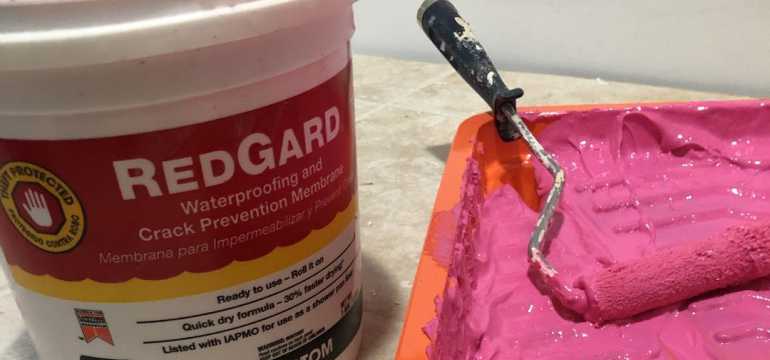Many homeowners find the need to have waterproof walls in their homes or garages for one reason or another. Fortunately, there are products on the market, such as Redgard, that allow you to coat your walls with a one-step waterproof membrane. While products like these do exist and serve a great purpose, you may not want to leave this as the final coat. Regard itself dries as a bright red color that may not be desirable long-term.
Can you paint over Redgard? This critical question is often asked by homeowners, but the answer is not as clear as a simple yes or no. Let’s take a closer look at whether you can roll out a coat of fresh paint over top of your new membrane.
Is Redgard paintable?
Unfortunately, it will not be warrantied for use with paint on top of it. However, Custom Building Products (the company responsible for producing Redgard) does offer some recommendations for homeowners who wish to try it anyway. If you have been planning to paint over Redgard waterproofing, here are a few of the things that you need to know.
First, you will need to plan on painting with a primer. They recommend that you attempt to prime the walls first and then apply a second layer of paint. It may be possible to paint the walls with a one-step product that includes paint and primer all in one convenient pail.
The quality of the primer you use is most likely to dictate how successful you will be at painting over the Regard. Primer can be compared to glue, easily bonding with the waterproof membrane that you have installed. It sets the foundation for you to apply a final coat of paint in the color of your choice. Make sure that you apply a generous layer and cover all spots with the primer.
Acrylic paint is often the favored choice for your final coat of paint. Look for varieties that are 100 percent acrylic if you know that you are going to be painting over Redgard.
Final verdict: Can I paint over Redgard?
If you have been wondering whether you can roll out a fresh coat of paint over the deep red color of your Redgard, it might be time for you to forge ahead. Painting your waterproof membrane may not be warrantied, but it is possible.
Remember that you will have to use a good quality primer or an all-in-one paint for the best chance at success with your fresh coat of paint. You can easily create a room that is beautiful and waterproof with a few of these helpful hints for working with Redgard.
Can You paint Redgard over silicone?
Before you dive right into painting your waterproof areas, you might want to know a few things about the Redgard itself. It is an excellent product for adhering to walls and Durock panels, but it does not adhere to everything. When you are building up your shower or tub surrounds, many people use silicone caulking to seal everything.
Silicone caulking should be the last thing installed when you are building a waterproof area. Nothing is going to stick to the caulking, including your Redgard. It is far better for you to paint the Redgard over the edges of the Durock or other cement board in order to create a completely waterproof barrier. After everything has dried, then you can put out your silicone caulking to seal everything up.
If the silicone caulking is already in place, you will have to remove it in order to seal the cement board properly. While this can be a real hassle, it is extremely important if you want to make your tile or stone installation waterproof and crackproof.
What is Redgard designed to do?

First and foremost, it is important to understand what Redgard is actually designed to do. It is a waterproofing and crack prevention membrane that creates a seamless waterproof barrier. You roll, paint, or spray two coats of this membrane onto the desired surface in order to prevent future cracks or damage from water. It is often used on shower walls and other places where high moisture could be a problem.
It is technically designed to receive a tile or stone installation within 72 hours of application. The Redgard is created to prevent cracks that could ultimately damage your tile or stone installation, as well as make the wall behind the tile waterproof. Ideally, the product is made so that you do not ever see the final product behind your brand new substrate. Perhaps that is why they did not select a more favorable color.
When you first roll the product onto your walls or floor, the color is bright pink. The product dries relatively quickly, and it changes color as it does so. That fluorescent shade of pink will give way to a deep red color.
This deep red color is not a desirable paint color for many homeowners. While it is useful for identifying whether any spots were missed, being in a room, this color might not suit your design tastes.
- How to Cut Lexan - September 25, 2020
- Mineral Spirits vs. Mineral Oil - September 25, 2020
- Shellac vs. Polyurethane - September 24, 2020
